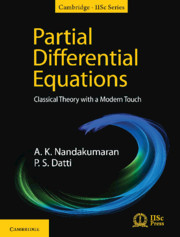Book contents
- Frontmatter
- Dedication
- Contents
- List of Illustrations
- Preface
- Acknowledgments
- Notations
- Chapter 1 Introduction
- Chapter 2 Preliminaries
- Chapter 3 First-Order Partial Differential Equations: Method of Characteristics
- Chapter 4 Hamilton–Jacobi Equation
- Chapter 5 Conservation Laws
- Chapter 6 Classification of Second-Order Equations
- Chapter 7 Laplace and Poisson Equations
- Chapter 8 Heat Equation
- Chapter 9 One-Dimensional Wave Equation
- Chapter 10 Wave Equation in Higher Dimensions
- Chapter 11 Cauchy–Kovalevsky Theorem and Its Generalization
- Chapter 12 A Peep into Weak Derivatives, Sobolev Spaces and Weak Formulation
- References
- Index
Chapter 9 - One-Dimensional Wave Equation
Published online by Cambridge University Press: 20 May 2020
- Frontmatter
- Dedication
- Contents
- List of Illustrations
- Preface
- Acknowledgments
- Notations
- Chapter 1 Introduction
- Chapter 2 Preliminaries
- Chapter 3 First-Order Partial Differential Equations: Method of Characteristics
- Chapter 4 Hamilton–Jacobi Equation
- Chapter 5 Conservation Laws
- Chapter 6 Classification of Second-Order Equations
- Chapter 7 Laplace and Poisson Equations
- Chapter 8 Heat Equation
- Chapter 9 One-Dimensional Wave Equation
- Chapter 10 Wave Equation in Higher Dimensions
- Chapter 11 Cauchy–Kovalevsky Theorem and Its Generalization
- Chapter 12 A Peep into Weak Derivatives, Sobolev Spaces and Weak Formulation
- References
- Index
Summary
INTRODUCTION
The wave equation
models many real-world problems: small transversal vibrations of a string,the longitudinal vibrations of a rod, electrical oscillations in a wire, thetorsional oscillations of shafts, oscillations in gases, and so on. It isone of the fundamental equations, the others being the equation of heatconduction and Laplace (Poisson) equation, which have influenced thedevelopment of the subject of partial differential equations (PDE) since themiddle of the last century.
We shall now derive equation (9.1) in the case of transverse vibrations of astring. Physically, a string is a flexible and elastic thread. The tensionsthat arise in a string are directed along a tangent to its profile. Weassume that the string is placed on the x-axis, with itsend points at x = 0 and x =L (not shown in the figure); see Figure 9.1.
We consider small transversal vibrations of the string, so that the motion ofthe points of the string is described by a functionu.(x; t), which givesthe amount that a point of the string with abscissa x hasmoved at time t. We also assume that the length of elementMM′ of the string corresponding tox and x +Δx; Δx being very small,is equal to Δx. We also assume that the tension ofthe string is uniform and denote it by T.
Consider a small element of the string corresponding to the abscissa pointsx andx+Δx. ForcesT act at the end points of this element along thetangents to the string. Let the tangents make angles𝜙 and 𝜙 +Δ𝜙 with x-axis, atM and M′, respectively. Then,the projection on the u-axis of the forces acting on thiselement will be equal to
Since we are assuming 𝜙 is small, we use theapproximation sin 𝜙 = tan𝜙 and obtain
Next, let be the linear density, that is, mass per unit length, of thestring. Applying the Newton's second law of motion, to the smallelement of the string under consideration, we Obtain
Dividing by Δx throughout and putting, results in(9.1).
- Type
- Chapter
- Information
- Partial Differential EquationsClassical Theory with a Modern Touch, pp. 252 - 280Publisher: Cambridge University PressPrint publication year: 2020



